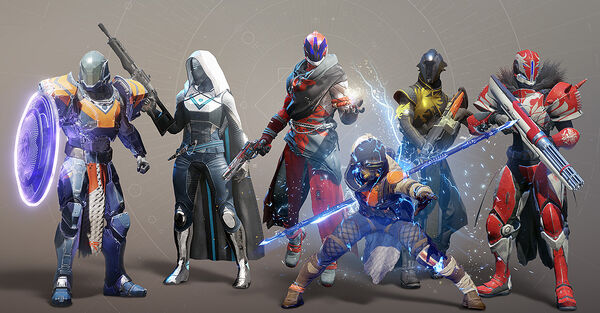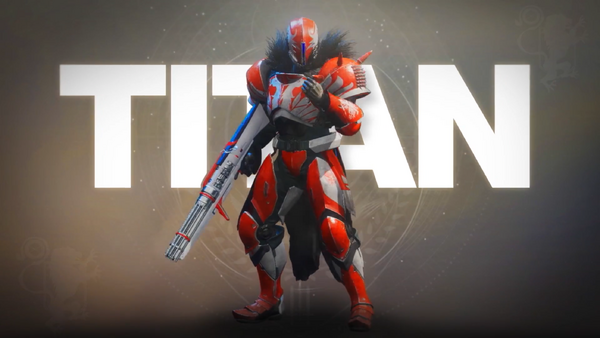The following post is sponsored ad content from Nvidia.
Whatever role you play in Destiny 2, you’re going to be dealing out generous portions of damage to the unruly and downright villainous alien races who threaten humanity’s survival. Choosing one of the game’s three classes is just about exactly how you want to deal that damage. Do you tend to favour a tank playstyle? Maybe you prefer to support your teammates with some well-timed abilities. Or perhaps you like to take a mobility advantage to a fight and run rings around your befuddled foes. In any case, Destiny 2 has you covered.
Before we run through the game’s classes in detail, it’s worth remembering that before you get started, you need to get game ready with the NVIDIA GeForce GTX 10 Series for the best experience of Destiny 2 on PC. And for a limited time, when you buy an NVIDIA GeForce GTX 1080 Ti or an NVIDIA GeForce GTX 1080 graphics card, system, or laptop, you’ll get Destiny 2 at PC launch .
On with the guide… The three classes - Titan, Hunter and Warlock - return in name from the original Destiny, but they’ve had a bit of a shake-up this time. Whether you dabbled with that original on consoles or you’re coming to Destiny 2 on PC for the first time, all you really need to know is that each of those three classes has two subclasses which will give you a bit more ownership of your character as you progress through the upgrade paths, and more specialisation in your role too.
Every class has a Super Ability (the big showstopper move which deals massive damage), Class Abilities, and up to four Subclass Passives, all detailed below. There’s no right or wrong to picking a class - instead it’s about deciding how you want to play, and choosing a build that matches your preferred playstyle. With that said, here are your choices.
Titan
As the name suggests, Titan is your common or garden tank, able to deal out plenty of damage and soak it up in huge quantities too. As a Titan your shields are more robust, and the upgrade paths available to you make it easy to buff up health and shield regeneration early in the game.
In either subclass, the Titan has the ability to drop a bulletproof Barricade in front of them, which comes in two forms: Towering Barricade, a tall protective wall, or Rally Barricade, wider but waist-high. These can be used to devastating effect in PvP modes by blocking off entry points to entire zones of the map, or halting the opposing team’s route to an objective. In PvE too, Barricades help you stay at the front of the battle for longer, and should enemies walk into them they’ll be slowed and take damage. Handy to have in your arsenal, then.
The Titan’s split into Sentinel and Striker subclasses, and although both have access to those Barricades, elsewhere things get more specialised. The Sentinel’s Super Ability, Sentinel Shield, basically turns them into a havoc-wreaking purple Captain America, able to bash enemies with said shield for massive damage, throw the shield once per activation for even more damage, or use it as - well, a shield.
The Strider goes all out on the offensive with their Fists of Havoc Super Ability. It’s an especially devastating ground pound attack which you can deploy on the ground underneath enemies, or alternatively shoulder-charge into them and even chain attacks. The result is pretty much the same: a screen full of /big/ numbers flying above enemies’ heads, and a lot of corpses lying about when it enters cooldown. The difference in these Supers, and in the available Passives for each subclass, make Titan Sentinel a great pick for a defensive tank playstyle, and Striker the more attractive of the two for a more mobile damage-dealer.
Hunter
If Titan sounds a bit too plodding, the Hunter class’s litheness, verticality and dodge abilities provide the perfect alternative. Jumping up into the air with the level of speed the Hunter class allows can actually confuse enemies and cause them to lose sight of you, allowing you to reposition and start laying down some damage again from a more advantageous position.
Hunter Class Abilities are, like the Titan, the same for each subclass: either Marksman’s Dodge and Gambler’s Dodge are available. The former performs a flashy, and potentially life-saving, lateral dodge animation while instantly reloading your gun. Gambler’s Dodge, on the other hand, restores melee energy while you dodge near enemies. If you’re playing the Hunter Arcstrider subclass, that’s where things get really interesting: The Combat Flow Passive recharges your dodge ability after performing a melee kill, so you can use the two abilities to chain melee kills.
If Titan Sentinels become Captain America upon activating their Super, Hunter Arcstriders become Jedis. The Arc Staff Super gives you - as one might guess - a staff which deals out huge Arc energy damage in either fast or heavy attacks. These acrobatic attacks are pure Darth Maul, and allow you to cover a lot of ground in a short time to take out many enemies. Meanwhile, the Gunslinger subclass gets the Golden Gun Super, which does exactly what you’d expect: gives you a golden handgun that obliterates foes with solar light.
Both Hunter subclasses are about mobility, then. The difference is in the emphasis on melee attacks for the Arcstrider, or lighter weapons for the Gunslinger. If you play a lot of Genji or McCree in Overwatch, these are the subclasses you’ll feel most at home with right away.
Warlock
If Titans live right at the tank end of the scale and the mobile but fragile Hunters can be plotted at the other end, Warlocks go somewhere in the middle. That’s not to say they’re a boring all-rounder class, though. In fact this might be the most distinct class of the lot. For anyone used to playing a support role in shooters such as Team Fortress 2 or Overwatch, the Warlock class offer a familiar starting place, but it also has some emphasis on getting airborne and staying there, forcing enemies to have to deal with the aerial threat.
That support role comes from the Class Abilities, Healing Rift and Empowering Rift. They’re not cryptic names: Healing Rift lays a small zone out in which you and your team can heal, and Empowering Rift opens a zone which buffs damage, again for you and your team when they enter it.
Subclasses are divided into Voidwalker and Dawnblade. Voidwalker’s Super, Nova Bomb, is unique in that it’s thus far the only ‘fire and forget’ Super type in the game. Activating it throws out an enormous ball of Void energy which explodes into smaller balls on impact, leaving you free to move around the battlefield dispensing damage while the Nova Bomb does its thing independently of you. Dawnblade plays more to the Warlock’s aerial strengths, bestowing the Daybreak Super Ability which grants you solar light blades to throw at your opponents from on high.
The power of those two Supers demonstrates Warlock’s capacity as a damage-dealer in addition to a support class. A good Warlock will certainly have an eye on team-mates’ health bars and know when a good damage buff will come in handy, but they’re certainly not relegated to the sidelines.
Whichever class you opt to play as in Destiny 2, don’t forget, for a limited time, when you buy an NVIDIA GeForce GTX 1080 Ti or an NVIDIA GeForce GTX 1080 graphics card, system, or laptop, you’ll get Destiny 2 at PC launch.




